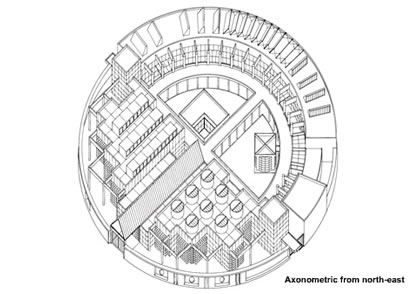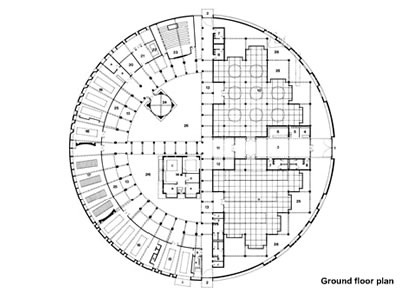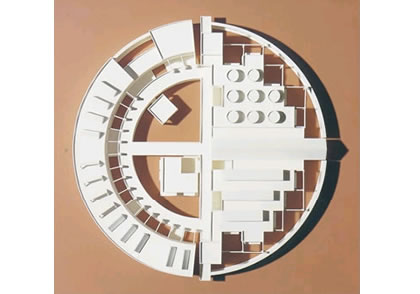 |
UCSB Art Museum Santa Barbara, California
Competition Project, 1983
The University of
California, Santa Barbara (UCSB) and the National Endowment for the
Arts jointly sponsored a competition for the design of a new university
art museum. The existing museum is an integral part of UCSB's academic
programme and at the same time one of the most publicly visible institutions
on campus, with an active schedule of exhibitions. symposia, lectures
and other events directed not just towards students but to the community
at large.The museum also encourages use of its programmes by other departments
within UCSB and the University of California system. The additional
spaces of the new museum were to provide more adequate accommodation
for existing programmes while broadening the possibilities for new ones.
UCSB is located about ten miles from downtown
Santa Barbara. The campus sits on an 815-acre promontory on the Pacific
seashore and is bordered on two sides by the ocean; the third side faces
the community of Isla Vista, the fourth looks across the Goleta Valley
to the Santa Ynez mountain range. The campus contains most of the 49
permanent buildings which house the university.
The new museum covers a total of 18,280 square feet, of which 8,800
are for galleries, 5,400 for services, 3,200 for museum programme research
facilities. and 880 for administration.
The complex is conceived as a single-level.
circular 'citadel' 240 feet in diameter. East-west and north-south axes
establish the primary and secondary entries and circulation zones, which
in turn provide north-east and south-east quarters for the principal
gallery spaces The western half contains all gallery service and museum
programme research facilities in a crescent configuration. The primary
entrance is from the east. through a high linear lobby, which bisects
the galleries and focuses on an inner courtyard containing two pavilions,
one for administration, the other for the seminar/conference space.
All activity areas have been organised according
to their programmatic requirements and have been clearly articulated
both in plan and form. Expansion can take place within the established
circular plan without compromising the initial circular configuration.
In addition, the proposal allows all spaces to expand independently
and in stages to a maximum of 40 per cent, as requested by the programme.
It is possible to close or isolate the galleries without diminishing
the overall architectural environment, as the complex can be entered
through the north and south gates and circulation and all other activities can
take place independently. Special attention has been paid to the design
of the gallery spaces to ensure an intimate scale and ambience for viewing
art. The galleries have roof lights and natural light, which can be
eliminated when desired through the use of blinds.
In conclusion, the project concerns
itself with the issues of context, place, display, and above all,
with the belief that university buildings should be architecturally
exciting, didactic and information-oriented artefacts.
Architects
: Panos Koulermos and Jay Nickels of Reibsamen, Nickels, Rex + Koulermos
Collaborator and modelmaker: AIek
Zarifian
Photo
: Tony Nagelmann
Below
: Axonometric from north-east; Ground floor plan
|
 |


